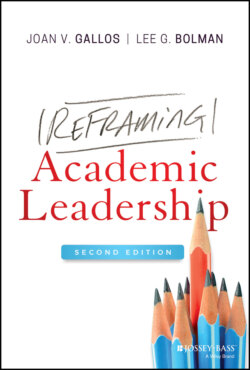Читать книгу Reframing Academic Leadership - Lee G. Bolman - Страница 10
Outline of the Book
ОглавлениеThe chapters in Part I (Leadership Epistemology: When You Understand, You Know What to Do) develop a central theme in the book: deep thinking and learning are at the heart of effective leadership. The opening chapter (Chapter 1: A Tale of Two Presidents: Opportunities and Challenges in Academic Leadership) contrasts the experience of two talented, well‐known, long‐term college presidents in very different institutions whose presidential denouements were sharply contrasting. Their stories provide an entry point for exploring the many factors that make leadership in colleges and universities simultaneously complex, satisfying, and dangerous. Chapter 2 (Sensemaking and the Power of Reframing) explores how you come to know and understand your world and the people in it, and how your thinking can limit or enhance your vision, choices, and strategies. Chapter 3 (Knowing What You're Doing: Learning, Authenticity, and Theories for Action) extends the discussion of sensemaking to the specific issue of learning from experience and from relationships with others. Starting from a key premise that leadership is in the eye of the beholder, it discusses how leaders can learn more about their tendencies, strengths, and gaps.
Part II of the book (Reframing Leadership Challenges) focuses on the big picture: how to understand the institutional landscape and translate intentions into effective action. We take on four of the knottiest concerns endemic to higher education administration and use a variety of case examples to provide concepts and guidelines for both diagnosis and action. Chapter 4 (Building Clarity and Capacity: Leader as Analyst and Architect) addresses the leader's role in institutional structure and design, as well as the challenges in building linkages that enable people to work together in institutions that often seem designed for disconnection and dissension. Chapter 5 (Respecting and Managing Divergent Agendas: Leader as Compassionate Politician) tackles head‐on how leaders can best handle political realities they would often prefer to avoid: enduring differences and the ubiquity of conflict in higher education. Chapter 6 (Fostering a Caring and Productive Campus: Leader as Servant, Catalyst, and Coach) examines the complexity and importance of managing people in ways that foster respect, creativity, and commitment. Chapter 7 (Keeping the Faith and Celebrating the Mission: Leader as Prophet and Artist) uses a contemporary case at a well‐known public university to explore ways that academic leaders can bring meaning and vision to their institution by embracing skills and strategies often associated with spiritual leaders and spirited artists.
Part III of this volume (Leadership Pragmatics: New Ideas for Old Challenges) tackles a series of issues that are chronic features of academic leadership. Each of the four chapters offers practical advice on how to diagnose and respond to recurrent dynamics that can derail even the most skilled. Chapter 8 (Leading from the Middle) examines the opportunities and hurdles in working with multiple constituencies. When you are buffeted by conflicting demands from every direction, how do you cope? Chapter 9 (Managing Your Boss) addresses the important but often neglected issue of how to influence and work effectively with your boss and other powerful players in the institutional hierarchy. Leadership is sometimes equated to managing people who report to you, but wise academic leaders understand that leading up is every bit as important. Chapter 10 (Managing Conflict) explores a perennial hazard of administrative life: conflict. Effective administrators look for the possibilities in conflict and use it to foster creative problem solving, to build commitment, to weed out inefficiencies, and to make wise trade‐offs among competing institutional objectives. We offer tips for how to generate lasting solutions from thorny situations by orchestrating disagreements so that things don't get too hot or too cold for progress. Chapter 11 (Leading Difficult People) addresses ways to productively handle the dysfunctional relationships and rogues’ gallery of idiosyncratic folks who sometimes seem overrepresented in higher education. People problems regularly top the list of challenges that can easily overwhelm leaders’ coping strategies and produce harm for both academic administrators and their institutions.
Part IV (Leadership in a Changing World) looks at the larger world in which higher education is embedded, emphasizing strategy, context, and the power of a clear direction. The first two chapters review and reframe today's challenges as tomorrow's opportunities for innovation and growth. Chapter 12 (Coping with a World in Motion: Students and Faculty) explores needs and changes for two of higher education's key constituents: students and faculty. Chapter 13 (Coping with a World in Motion: Money and Technology) examines the perennial issues of funding and technology as complications on the road to a better future. Chapter 14 (Leadership, Strategy, and Governance: Institutional Survival) examines the roles of both boards and academic leaders in building a workable strategy and working relationships that chart a course toward institutional well‐being.
Part V (Sustaining Higher Education Leaders: Courage, Hope, and Values) focuses on the deeply personal relationship between leaders and their work. The chapters are written to sustain (or reawaken) your search for the best in yourself and in your institution. Chapter 15 (Sustaining Integrity: Ethics and Leadership) looks under the rocks of several well‐publicized ethics scandals, asking why such things keep happening and what leaders can learn. Chapter 16 (Sustaining Health and Vitality) addresses the reality that administrative life can tax a leader's physical and psychological health. The chapter offers a series of steps academic leaders can take to sustain their stamina and work–life balance. Chapter 17 (Feeding the Soul) explores the ethical and spiritual dimensions of higher education leadership: the role of faith, calling, and a deep sense of self as essentials for steering academic institutions and programs to greatness.
We conclude with an Epilogue (The Sacred Nature of Academic Leadership) that challenges higher education leaders to recognize and embrace the sacred nature and moral purpose of their work.
